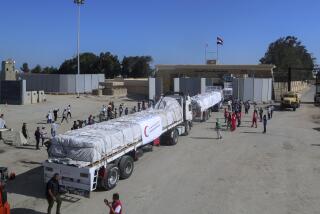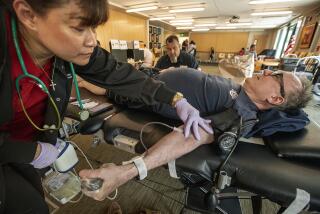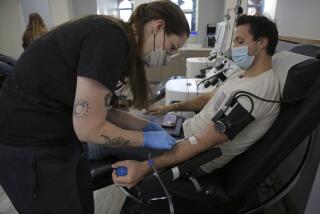Blood Supply in Many Poorer Nations Unsafe, Experts Say
The supplies of blood available for medical transfusions in the United States, Canada, Australia, Japan and most of Western Europe are extremely safe, thanks to increasingly sophisticated screening for AIDS, hepatitis and other contagious diseases.
Such screening, however, continues to be largely unavailable in Africa, China, the Soviet Union and much of Eastern Europe and the Middle East, resulting in blood supplies contaminated with disease.
Those assessments of the world’s blood supply were presented by physicians and health care professionals in Los Angeles on Monday at the 1990 Joint Congress of the International Society of Blood Transfusion and the American Assn. of Blood Banks.
Experts said that while blood banks in most Western industrialized nations experience only periodic shortfalls in blood and blood products, many of the world’s poorest and least developed countries continue to suffer from chronic shortages of blood, resulting in thousands of deaths every year.
“Blood can never be guaranteed safe,” said Dr. Gordon T. Archer of the Red Cross Blood Transfusion Service in Sydney, Australia, and president of the International Society of Blood Transfusion. “It never has been (100%) safe and probably never will be.”
Yet, Archer said, “in the United States . . . blood is safer today than it ever has been before,” despite AIDS and AIDS-related viruses and other recently discovered communicable diseases.
For every unit of blood transfused in the United States, there is less than a 1% chance of becoming infected with a serious disease, said Dr. Toby L. Simon, executive vice president and chief operating officer of Blood Systems Inc. in Scottsdale, Ariz., and president of the American Assn. of Blood Banks.
So safe is the blood supply in the United States, in fact, that two groups of scientists concluded in the New England Journal of Medicine this month that, even though it is possible to use an additional test to screen donated blood for the AIDS virus, it is unnecessary to do so.
According to researchers at UC San Francisco and USC who oversaw those studies, the existing test for the AIDS virus in donated blood is so effective that the odds of developing AIDS from tainted blood in the United States now runs somewhere between 1 in 38,000 and 1 in 153,000, which in medical terms is considered a minuscule risk.
The risks of serious infection from blood transfusions are similar in most other industrialized countries, but that is certainly not the case in many other areas of the world, said Dr. Richard J. Davey, a blood specialist at the National Institutes of Health who has been assigned temporarily to the World Health Organization in Geneva to study the world’s blood supplies.
In parts of the Middle East, Indonesia, Pakistan and India there is little or no screening, especially in rural areas, Davey said. As a result, in those countries, as well as in China, the Soviet Union and much of Eastern Europe, where almost no blood screening is done, the risk of contracting hepatitis and in some cases malaria or other contagious diseases from transfusions runs quite high.
One of the most contaminated supplies of blood in the world is in Africa, largely because of the high incidence of AIDS in that country, Davey said. Of the 8 million cases of human immunodeficiency virus infection, which causes AIDS, more than 5 million are estimated to be in Sub-Saharan Africa.
Between 65% and 70% of the 2 million transfusions given each year in Africa rely on blood that has not been tested. That rate is actually somewhat better than it has been in the past. “It is an improvement,” Davey said, but it is still not anywhere near what it should be.
One of the blood-testing problems facing many countries is outdated equipment.
In Eastern Europe, for example, blood is not collected in disposable containers as it is in the United States, but in glass bottles, which “haven’t been used in the U.S. since the 1950s,” Davey said.
Another problem in screening blood for disease is the cost of running the tests.
Blood screening runs between $5 and $10 per test, accounting for as much as half the total costs of blood transfusions. In the United States, there are now seven separate tests run on every unit of blood. The tests are designed to detect syphilis; hepatitis B; HIV, HTLV I and II (AIDS-related viruses), hepatitis C and and non-A and non-B hepatitis.
Some American health advocates contend that there is a need for other tests as well. For example, it is thought that Lyme disease, a debilitating inflammatory joint disorder transmitted by ticks, might also be transmitted through blood, although there have been no confirmed transmissions through donated blood.
Of particular concern to health officials in New York and Los Angeles is Chaqas’ disease, a major cause of heart and bowel disease in Central and South America. The disease, named for a Brazilian physician, is caused by a parasite that is normally spread by the reduviid bug (also known as the assassin or kissing bug). But in at least two documented cases cancer patients in the United States have gotten the disease from transfusions, leading some health officials to believe it may be time to begin screening for the disease, particularly in parts of the country where there have been huge influxes of immigrants.
Most experts, however, urge caution, saying the incidence of the disease is not yet large enough--and indeed may never become large enough--to warrant the imposition of a Chaqas test.
More to Read
Sign up for Essential California
The most important California stories and recommendations in your inbox every morning.
You may occasionally receive promotional content from the Los Angeles Times.










